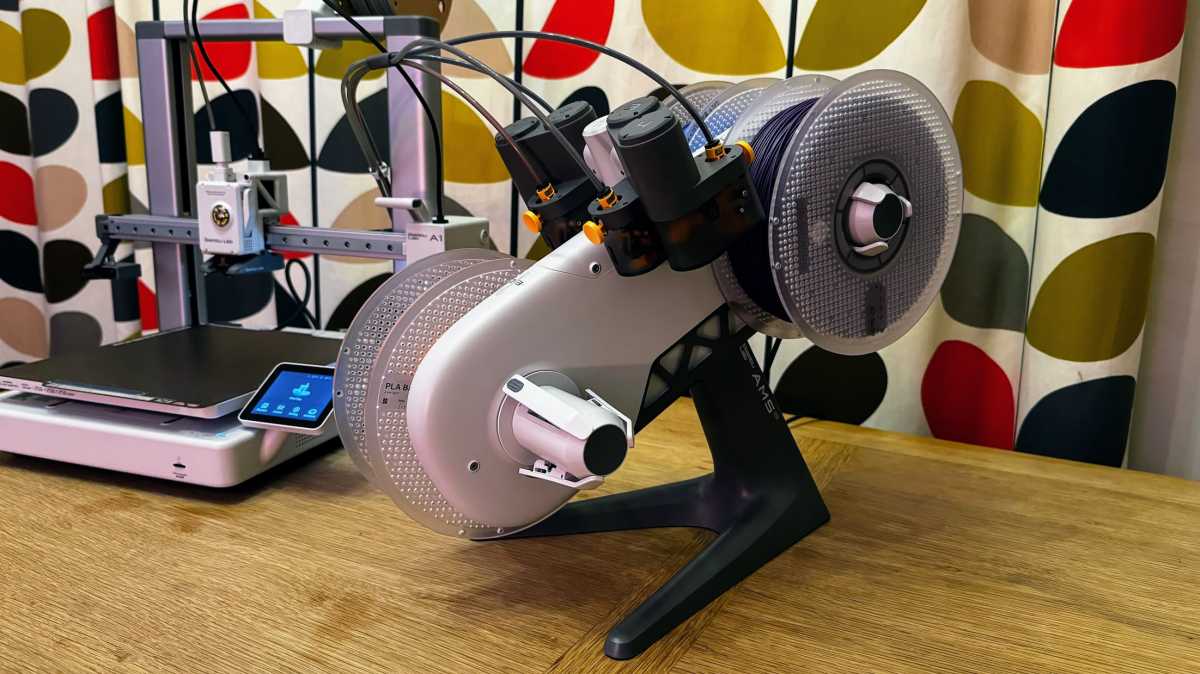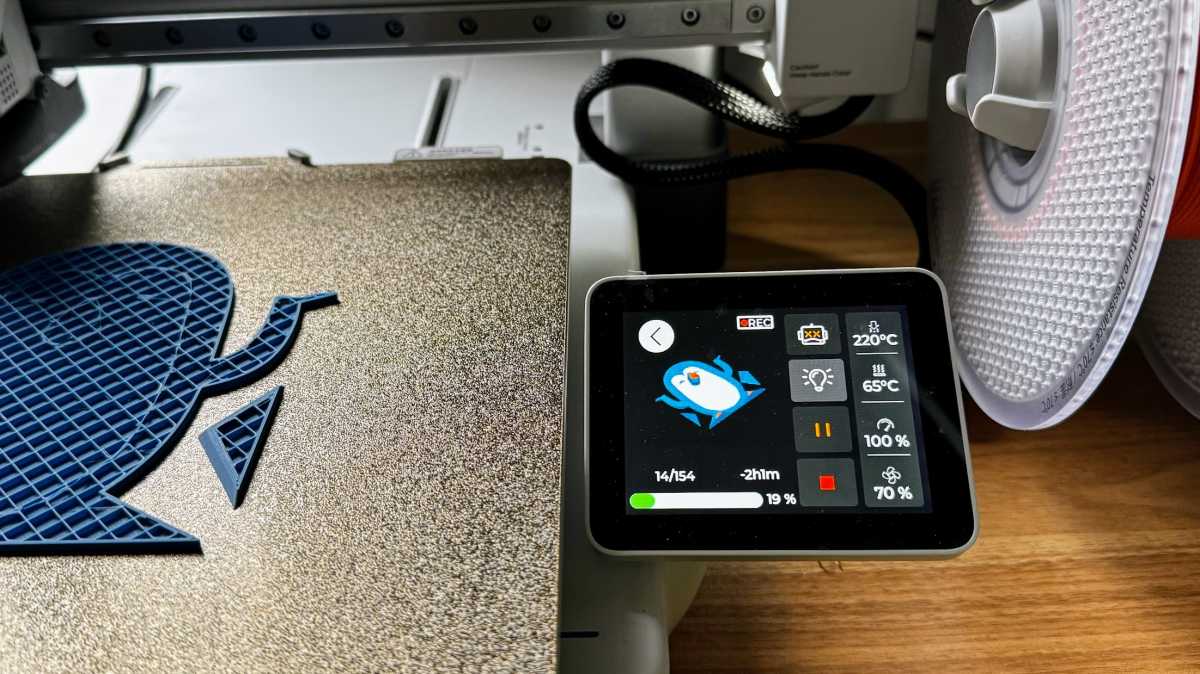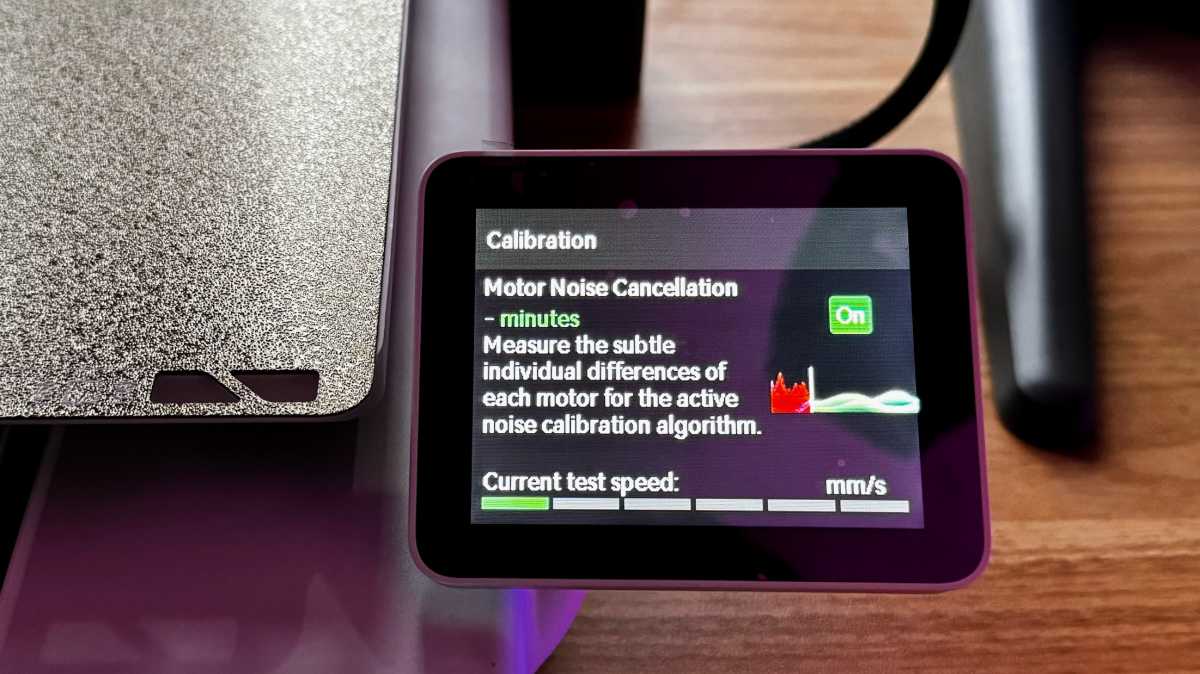Expert’s Rating
Pros
- 3D printing made simple
- Top notch print quality
- Great value
Cons
- No AI failed print detection
- ‘Painting’ models can be tricky
- Some third-party filament won’t fit AMS Lite
Our Verdict
Bambu’s A1 is a seriously impressive 3D printer that prints at high speed but delivers better quality than the competition, all without making a racket. Plus, if you get the Combo, you’ll be able to print in four colours at the same time.
Price When Reviewed
From $399 (Combo model $559)
Best Prices Today: Bambu A1
Quite why Bambu launched the A1 Mini before the A1 is anyone’s guess. But after just a few short months of waiting, the A1 gives those on a budget the option of a top-quality 3D printer that can – optionally – use the AMS Lite to print models in up to four colours at ‘normal’ sizes.
That means 256mm cubed: the same build volume that the pricier P1 and X1 models offer. The A1 Mini, as the name suggests, is smaller and can print models up to 180mm cubed.
Features & design
Instead of the usual black, Bambu has chosen a light grey for the A1 and, along with the rounded corners and covered X- and Z-axes, it looks much more like a modern consumer gadget than a lot of 3D printers, which tend to have the appearance of an overgrown Meccano set. It looks a bit like the Ankermake M5.
Aside from the obvious absence of an enclosure, this is a bed-slinger. Also known as Cartesian, it’s a different motion system to coreXY, which Bambu’s P1 and X1 models use.
Until recently, Cartesian printers were much slower than coreXY printers, but Bambu and others have worked out how to ramp up the speed without sacrificing print quality. Before I get onto some of the tricks the A1 has, it’s worth saying that you’ll need a fairly large amount of desk space for this printer because the bed moves forwards and backwards, extending beyond the printer’s footprint.
Also, if you go for the A1 Combo – or buy the AMS Lite separately – you’ll need considerably more space for this freestanding four-spool holder. It’s designed to be put on the right-hand side of the A1, but you can print a bracket to mount it on top of the gantry.

Jim Martin / Foundry
I didn’t try this, not because I was worried about flimsy build quality – far from it – but with four 1kg reels of filament, plus the weight of the AMS Lite itself, it seems best to let your desk take the strain rather than a 3D-printed bracket.
The A1’s spec list ticks all the boxes: an all-metal hotend that goes up to 300°C, a heated bed that will reach 100°C, a magnetic, textured PEI plate, fully automatic bed levelling, a decent colour touchscreen, and Wi-Fi for printing via the cloud.

Jim Martin / Foundry
There’s more. The printhead is the same as the A1 Mini’s, and it’s full of clever stuff. There’s an Eddy Current sensor which measures extrusion pressure for more accurate prints at speed, and a runout sensor and odometer to detect whether there’s filament and how fast it’s moving through the nozzle.
There’s a filament cutter, operated by the ‘finger’ on the right of the X-axis and, should you ever want to or need to, the nozzle is impressively easy to swap out, should you ever need to. It’s held in only by a clip and a strong magnet. All you have to do is press the filament cutter arm, pop off the plastic front cover and remove the silicon shroud: there are even instructions behind the plastic cover.
The nozzle is impressively easy to swap out, should you ever need to
At the rear of the print bed is a silicone wiper to remove filament before the auto-levelling process, and there’s a spare wiper included in the box.

Jim Martin / Foundry
On the left-hand side of the X-axis is a Purge Wiper. This is used to catch filament that is purged between colour changes or when a new filament is loaded. The only problem is that it isn’t designed to store the waste filament. Comically, it is ejected onto the desk – or your floor – so you’ll want to figure out a way to capture this, even if it’s just a box placed to the side of the A1.
Assembly and AMS Lite
Although Bambu could have feasibly shipped a slightly larger box and supplied the A1 fully built, it opted to do what most of its rivals so and get the buyer to screw the gantry to the base.

Jim Martin / Foundry
I really like the A1’s design in this respect, as the gantry is a full rectangle with a large foot that allows it to stand unsupported on the desk. You then tilt the base (above) and slide it through the gap, aligning the cutouts and pushing it home.
Then, you remove the plastic cover beneath the build plate and install 10 screws to hold the two pieces together. Once that’s done you flip it on its side and connect the three cables – all colour coded – and that’s pretty much it.
It still took me 45 minutes in total, because the AMS Lite also requires a bit of assembly: screwing the unit to its base, and pushing on the four reel holders. Unlike the P1S Combo and X1 Combo, whose AMS units use rollers to turn the spools, the AMS LIte grips the centre hole: it looks a bit like a giant cassette tape when you install two spools on the same side.
Also, instead of just one PTFE tube running from the AMS to the printhead, there are four. This is a benefit because the filament doesn’t have to be retracted very far when swapping colours, making colour changes a bit faster.
Motors within the AMS Lite turn the spools and feed the filament into the printhead, and colour changes are fully automatic.
If you don’t go for the Combo, or if you simply don’t want to use the AMS Lite for a bit, you’ll use a single spool holder (included in the box) which attaches to the top of the printer.

Jim Martin / Foundry
You can leave that holder installed permanently for times when you need to use a spool that won’t fit the AMS. I discovered that Creality’s cardboard spools don’t fit, and neither does its plastic ones, whose inner diameter is smaller than the 53-58mm supported by the AMS Lite.
The Bambu A1’s performance absolutely blew me away
Performance
The Bambu A1’s performance absolutely blew me away. Not only is print quality the best I’ve seen from any bed slinger, it’s also relatively quiet and very reliable.

Jim Martin / Foundry
I ran test prints for dozens of hours and was impressed that the A1 just got on with them with virtually no fuss. A lot of this is thanks to the sensors in the print head which reliably detect tangles or other problems with filament.
And if there are issues, it’s usually possible to recover from them. For example, I used up some high-speed grey filament from Anycubic and it tangled three times during a three-hour print. Each time, I got a notification from the Bambu Handy app and was able to fix the tangle and continue the print.

Jim Martin / Foundry
The bed temperature is kept high to ensure prints don’t come unstuck, and the only time a print wasn’t able to continue was after the A1 had been switched off mid-way through a print. It did continue for a bit, but the part eventually came loose as the bed had cooled down for a couple of hours in the meantime.
Any errors or problems are clearly shown on the screen or in the app, and Bambu uses codes – a little like the engine error codes you get when using an OBD-II reader on your car – which can be looked up on its wiki online.

Jim Martin / Foundry
The great screen also makes the A1 a joy to use compared to the P1S. It’s just the right size and the interface has been well thought out, so all the options you expect to see are right there. If there’s a tiny criticism it’s that it’s slow to refresh when you tap on something. But it doesn’t really affect usability.

Jim Martin / Foundry
In terms of noise, Bambu does some clever noise cancelling to quieten the motors at different frequencies. It works well, but the fans can still be quite noisy: they speed up and slow down when necessary, and at full power are pretty distracting. I wouldn’t want to work or sleep next to the A1 while it’s printing.

Jim Martin / Foundry
For testing, I mainly used Bambu’s basic PLA and got fantastic results. The dynamic flow compensation appears to work well, meaning parts come out the size they’re supposed to with crisp, clean edges.
Surfaces, especially vertical walls, are very clean and accurate, and overhangs are handled well. Tolerances are very good too, so you can confidently print articulated and hinged parts knowing they won’t get accidentally welded together.
Speed-wise, the A1 is very nearly as quick as the P1S and X1C, which is seriously impressive considering both of those are coreXY printers. Bed levelling and all the other initial calibration takes around five minutes, which isn’t much to add to a multi-hour print, and is similar to the P1S and X1C.

Jim Martin / Foundry
I printed the same plate containing multiple parts on both the P1S and X1C, and the P1S took a little under three hours, while the A1 took around 20 minutes longer at 3 hours 16 minutes. The time difference does become significant when prints take several hours longer than this, but it’s damn quick for a bed slinger, and don’t forget this is all with excellent quality.
It’s worth saying, too, that Bambu’s desktop (Studio) and mobile (Handy) apps are both impressive, even if Studio has a bit of a learning curve, particularly if you want to ‘paint’ models in various colours. Fortunately, Bambu provides profiles for its different filaments and nozzles, so it’s easy to select these in the apps and leave everything at the default settings.

Jim Martin / Foundry
The only thing I found frustrating was that the camera feed was slow to load, and seemed to provide one frame every couple of seconds – a worse frame rate than the P1S – but it’s enough to do a remote visual check that everything is ok.
And the only real gripe about the A1 is that it lacks any sort of print failure detection. So if a model comes adrift from the plate, the A1 will produce spaghetti until it finishes, or you check in and stop it.

A successful print sits next to a failed one
Jim Martin / Foundry
Price & availability
On its own, the A1 costs £369 / $399. That’s great value given the speed and features on offer.
You can buy it from Bambu’s website.
It’s also a lot less than the P1S, but remember that the A1 can’t handle warp-happy filament types such as ABS and ASA, which the P1S can thanks to its enclosure.
If you want multi-colour printing, go for the A1 Combo that includes the AMS Lite. That’s £509 / $559, cheaper than buying the two things separately.
Should I buy the Bambu A1?
If you’ve no need or desire to print things in ABS, ASA or other filaments that need an enclosure, then yes, the A1 is an absolutely superb 3D printer. It blows the competition out of the water and is well worth the price.
It even beats Bambu’s P1S in a few areas, including the touch screen and dynamic flow compensation. However, if you do want the option to print with a wider variety of filaments, don’t let the P1S’s lack of a touchscreen put you off as you really don’t need to use it very often.
The majority of home users probably won’t feel limited by the filaments the A1 can handle. PLA is plenty strong and long-lasting these days, and comes in the widest choice of colours and styles.
For alternatives, see our roundup of the best 3D printers.
Bambu A1 specs
- FDM 3D printer
- Steel + aluminium chassis
- All-metal hot end
- Nozzle diameter 0.4mm (optional 0.2, 0.6 and 0.8mm nozzles)
- Uses 1.75mm PLA/TPU/PETG/PVA filament
- Max print size: 256x256x256mm
- Max build plate temperature: 100°C
- Max nozzle temperature 300°C
- MicroSD slot + Wi-Fi
- 1080p camera
- Max print speed 500mm/s
- Max acceleration 10 m/s²
- AC 110-240V input
- 1300W power consumption (220V)
- Weight 8.3kg
- Printer size: 385mm×410mm×430mm (WDH)

